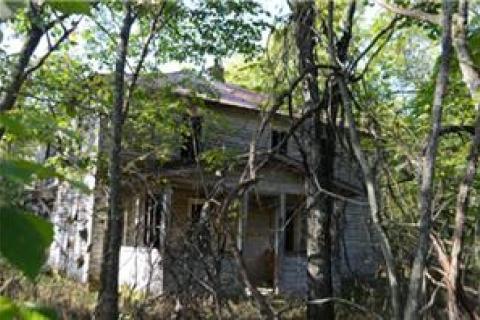
 |
| Deer hunters who live outside of those traditional big buck states or provinces must think creatively when it comes to locating a 150-inch plus trophy. An old homestead may look abandoned but may actually be visited by behemoth bucks in search of cover and forage. |
Even in today’s world of quality deer management, with the many great food plot mixes and minerals and other factors that help produce big bucks, it is still difficult to harvest a buck 150-inches or better.
The world of whitetail deer hunting is full of myths and mysteries, but I once heard that only 1 in 10,000 bucks reach the 150-inch class. I tend to believe that statement. Most buck hunters are fortunate to harvest one or two 150-inch or better bucks in their entire hunting lives.
Hunting where big bucks grow obviously increases a hunter’s chances of taking a monster. However, for those who may never afford a hunt in Kansas, Iowa or Saskatchewan, they have to hunt smarter to have a chance at a big buck.
Following are some tips on places to find big bucks, regardless of where you live. Every season, a few big bucks show up in soil poor regions such as the Missouri Ozarks. To improve your odds of finding that buck of your dreams, search these out-of-the-way places that big bucks hide.
1. Abandoned Barn Lots
Many agricultural areas have seen drops in farming families over the last few decades, particularly in areas with marginal soils. Abandoned farms often have old barns and feed lots that have grown over with saplings and other dense vegetation. Decomposed animal manure in these lots creates rich soil environments, which provide high nutrition food and thick cover — the perfect big buck hideout.
2. Small Swamps
I got the surprise of my deer hunting life one season when I decided to walk through a half-acre swamp in the middle of a 300-acre soybean field. I immediately began seeing serious rubs, scrapes and droppings upon breaking through the initial wall of cattails and multi-flora rose. A few steps into the dense tangle, a massive buck exploded from underfoot. I had walked by that spot dozens of times. A buddy later killed that buck. It scored 182.
3. Seep Springs
Small seep springs are common in hill country. Most go unnoticed, except by wildlife. They provide hidden drinking spots for a variety of wildlife, including white-tailed deer. Toss in dense stands of willows, cattails and sedges, and you have the perfect big buck hideout.
4. Honeysuckle Thickets
Honeysuckle was introduced to the Missouri Ozarks in the 1950s as an ornamental plant and ground cover. The fast-spreading vine covered small corners and pockets of vegetation, which were not cultivated, grazed or mowed. Honeysuckle tangles quickly attract deer because of the forage and cover it offers. It grows so thick few humans ever venture inside. Rabbits love the tangles, too. I discovered the big buck potential on a rabbit hunt, when my beagles pushed a monster out of a two-acre honeysuckle patch, surrounded by hardwood forests.
5. Abandoned Farm Buildings and Homes
Old barns lots are not the only places on abandoned farms that attract big bucks. Soil is disturbed during the construction of farm buildings and homes, creating ideal spots for thick vegetation to grow. Once buildings are abandoned and farms neglected, the natural progression begins and big bucks soon notice. Old apple and pear orchards sometimes exist in the middle of overgrown areas surrounding farm buildings as well, creating a haven for big bucks to hide.
I will never forget exploring an old farm with a majestic, dilapidated mansion and a grand old barn. Deer tracks entered old stalls of the barn. I should have not jumped so when a huge buck bolted from its bed as I broke through a tangle of vines to view the front porch of the southern mansion. My mind however, had been occupied by tales of ghosts and bushwhackers.
Deer hunters living in swampy areas of the country have their own set of challenges. Check out this article for advice on finding and tagging a swamp country buck at Bass Pro Shops 1Source.
- 11166 views

